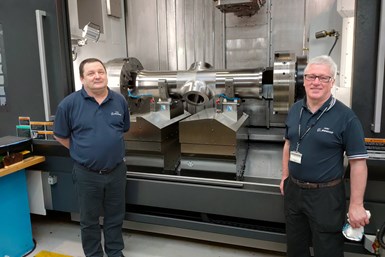AMRC Reduces Aircraft Bogie Beam and Axel Weight by 20%
AMRC machined the two bogie beams from a titanium alloy, which is stronger, more robust and lighter. The goal of the project is to improve the efficiency of landing gears and support the vision for cleaner aviation.
Share



Autodesk, Inc.
Featured Content
View More

ECi Software Solutions, Inc.
Featured Content
View More


.png;maxWidth=45)
DMG MORI - Cincinnati
Featured Content
View More

A team of University of Sheffield Advanced Manufacturing Research Centre (AMRC) engineers were tasked with machining an aircraft bogie beam and axle assembly that reduces weight by 20%. This would reportedly improve the efficiency of landing gears and support the vision for cleaner aviation. The project is part of the Large Landing Gear of the Future program led by Safran Landing Systems and partially funded by Innovate U.K.
“Safran radically redesigned their bogie beam and axles and coupled this with a revised material supply, which they believed would create a structure that is 20% lighter than its predecessor and will increase time between overhaul (TBO) from 12 years to 20,” says Dan Smith, technical fellow in the aerostructure and landing gear team at the AMRC.
Steel and aluminium are widely used in landing gear components. However, Safran asked the AMRC to machine two bogie beams from a titanium alloy, which is stronger, more robust and lighter. Smith says with those qualities come significant obstacles. “The titanium alloy has great mechanical properties, but it is seldom used in aerospace because it is so difficult to machine,” Smith explains. “It is unforgiving and often leads to rapid onset accelerated tool wear.”
A first-off bogie beam manufactured in the titanium alloy has precisely met Safran’s expectations. Smith says the next stage of the AMRC’s program of work is to machine the axles that will be assembled to either end of the bogie beam.
“The axles are in production now,” Smith explains. “Once the parts are finished, we will send them to Safran who will assemble them into place. They will then return to the AMRC where we will finish the machining of the bogie beam and axle assembly at Nuclear AMRC on the Soraluce FX12000.”
Related Content
-
5 Tips for Running a Profitable Aerospace Shop
Aerospace machining is a demanding and competitive sector of manufacturing, but this shop demonstrates five ways to find aerospace success.
-
Machine Monitoring Boosts Aerospace Manufacturer's Utilization
Once it had a bird’s eye view of various data points across its shops, this aerospace manufacturer raised its utilization by 27% in nine months.
-
Broaching Tool Technology For Lathes Used to Slot Inconel Parts
This shop finds value in using an indexable-insert-style broaching tool to create blind-hole slots in heat-treated Inconel aerospace parts on a CNC lathe.






























.jpg;maxWidth=300;quality=90)






